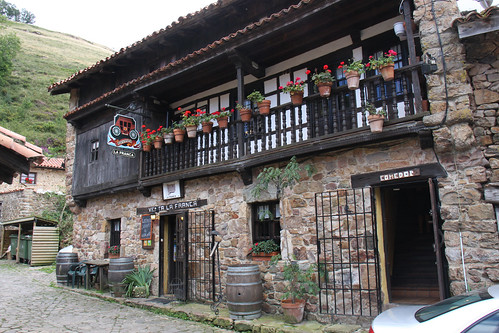Bárcena Mayor - The Oldest Town in Cantabria

When discussing what sort of mischief and/or tourism we could get up to last Sunday, my wife mentioned that a friend had recommended visiting "the oldest town in Cantabria". With only this tidbit to go on, I turned to Google and discovered a Cantabrian tourism site with the sentence, "It is said that [Bárceno Mayor] is the oldest town in Cantabria, and possibly even all of Spain." Yet nowhere on the great big internet could I find out how old the town was thought to be. It was also unclear how one would even determine how old a small town is when it's nestled in the mountains near a cave with 15,000 year old Paleolithic cave paintings. Investigating further, I looked up Bárceno Mayor in Google Maps and noticed that Street View was an option. This is what I saw:
Oh yeah! This looks like the kind of place I'd like to spend my Sunday! We put on a little sunscreen, grabbed a bottle of water and hopped in the car for a ninety-minute drive west to The Oldest Town In Cantabria.
On the way there, we passed all these gorgeous quaint little villages, some clearly having festivals, with people sitting out on the terraces of bars and restaurants soaking in the August sun. It was really hard not to stop and just enjoy one of those towns, but we persevered through the windy mountain roads up to Bárcena Mayor. Just when my GPS navigation unit told me we were 200 meters away from our destination, we saw a sign into the Bárcena Mayor parking lot. No village was in sight. We parked among the 60 other cars and walked up a little path. What was the first sight we saw?

Hey! That looks familiar!
By this time it was 2:00 PM, i.e. approaching Spanish lunch time, and we thought was should find an eating establishment. Google only listed one place, and there were a couple dozen tourists around to compete with, so I suggested urgency.

Ooh! I see a restaurante! Plus, they're advertising "typical cuisine"!

We ate at La Franca.

For the first course, I had beans with wild boar. It was delicious! Spaniards eat quite a bit of wild boar. I've never seen it on offer anywhere in the United States.

Continuing the "not everyday meat" trend, I had a fillet of venison for my second course. Doe, a deer, a tasty, tasty deer.

Bellies full of meat and red wine, we wandered around town in a contented stupor. All the buildings were very old. I pointed out the wires running along the wooden beams of the restaurant, commenting, "Hey, check it out. This building was built before they had electricity!" My wife shrugged and reminded me that her parents grew up in a house without electricity or running water. Oh yeah. I often forget how far Spain has come in just fifty years.

The cobblestone streets and combination of wood and stone house construction made it feel like we'd been transported back in time several centuries...until we turned the corner and saw a Prius.

That every house was decorated with blooming flowers definitely added to the general pleasantness of the town.

Another restaurant we might have preferred for the view if we hadn't just chosen the first one we saw.

We crossed a bridge and discovered a hiking trail. If we'd had better shoes on, we might've walked a few kilometers of it, but we hadn't come prepared for that. Sounds like a good excuse to go back!

Looking down from the bridge. I've been wanting to do one of these long exposure water flow shots for some time. I was surprised that just a half second is long enough to get the nice blurring effect.

Looking up the staircase inside the church bell tower.

It became clear that the town's only industry was tourism. Why anyone would want to buy a wooden pitchfork is beyond me. We did end up buying some Cabrales cheese. The guy at the orujo (liqueur) stand was so generous with his little tasting cups and we ended up buying some yogurt liqueur. It's really quite tasty. We even ran into some Americans at that shop and helped translate a few things for them.
There were just the right number of tourists around: enough to give you the feeling that the town was alive, but not so many where you couldn't avoid hearing their conversations. I can't imagine what the town must be like in the middle of winter. Perhaps we'll have to book a room at one of their quaint little posadas and see.
To answer the question I raised at the beginning, according to the information plaque, Bárcena Mayor dates back to the ninth century (CE), and was the site of various monasteries over the centuries. Of course claiming that your little 1200-year-old mountain valley town is the oldest in a region that was part of the Roman Empire is pure nonsense, but you've got to admit, it makes for some really excellent tourism marketing! If you're in Cantabria looking for a well-preserved historic village to visit, I highly recommend Bárcena Mayor.